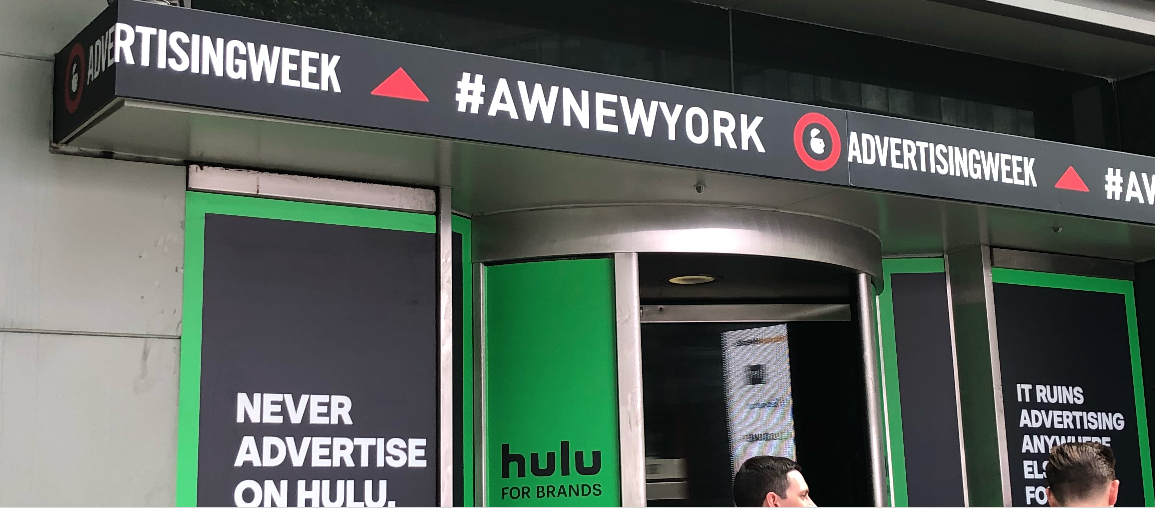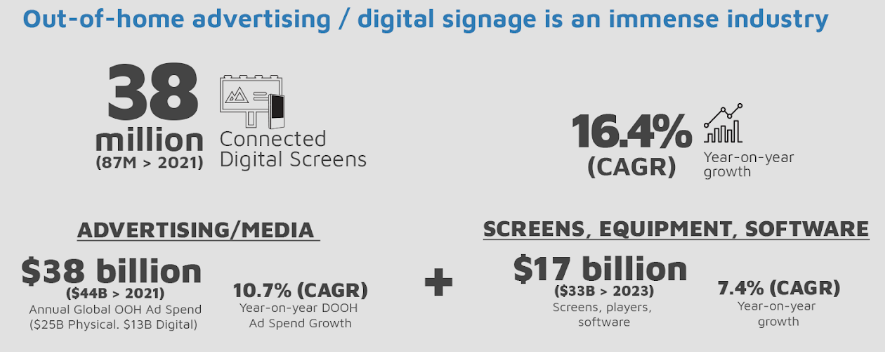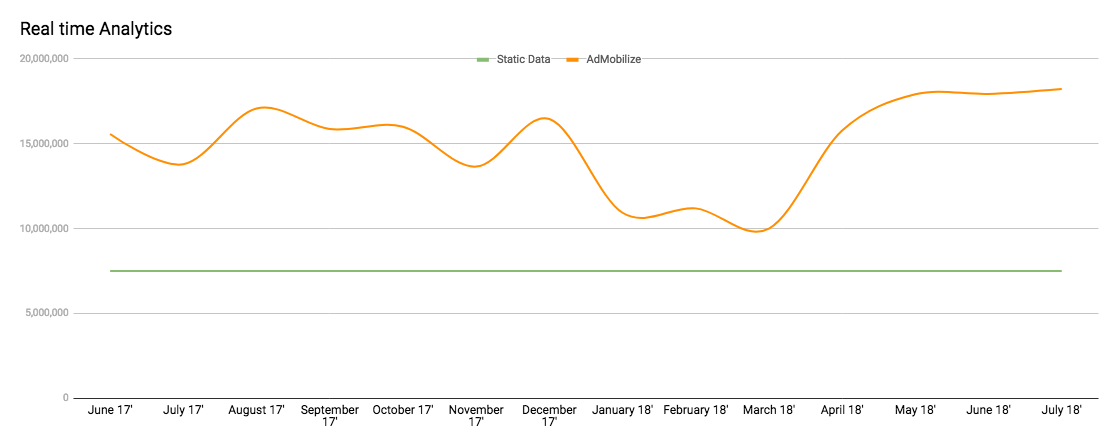
Why Digital OOH Will Eventually Require Real-Time Performance Metrics
October 12, 2018 by guest author, sixteenninewpadmin
Guest Post: Rodolfo Saccoman, AdMobilize

Saccoman
I love AdWeek in NYC; it always exudes elevated levels of “thinking collisions per capita” in the advertising industry.
Obviously, I am not siloed on being bullish about the growth projections of outdoor advertising and digital signage. Research suggests a global OOH ad spend of $38B for 2018, with 38 million connected digital screens (for advertising, communications, wayfinding, menu boards, and so on).
Particularly this year during AdWeek, it seemed out of home advertising (OOH / DOOH) was having a feast of media coverage, including AdAge and Recode among other high visibility pubs.

REAL-TIME DATA WILL UNLOCK REVENUE
I see the OOH industry reaching the beginnings of an exponential revenue scalability curve. Don’t look too far for benchmarks, just focus on the Internet, PC, and Mobile ad industries.
The needle moved for Internet advertising when:
- Hardware costs were significantly reduced (cheaper phones, PCs, laptops)
- Higher processing power, drove smarter devices
- Connectivity became abundant
- Publishers (operators) opened up their inventory gates
- Advertisers easily understood the mechanisms to buy the new media
- Ad exchanges and programmatic engines integrated with existing software
- Real-time, proof-of-performance data became the enabling currency
The above-mentioned scenario is being duplicated right now for OOH. The pieces of the puzzle are finally coming together.
Today, I will focus on how real-time, proof-of-performance data became the enabling currency. Without true proof-of-performance data, the mobile and PC advertising industries would not have flourished as they did. Real-time viewership and engagement metrics were the catalyst that provided brands and advertisers the confidence to move budgets from print, radio, and television into Internet advertising.
Mark Twain acknowledgedly said that “History never repeats itself, but it rhymes.” If you compare the inner workings of both the OOH to the Online/Internet advertising medium, the similarities abound. Furthermore, the timing and circumstances which unleashed the digital advertising boom, mimics the current moment of the outdoor advertising landscape.
The defining KPIs that catapulted Internet advertising were:
- Impressions > How many people were exposed to my online ad?
- Engagement, CTR (click-through rate) > How many of those people actually clicked on my online ad?
Those two fundamental metrics powered the entire ecosystem and it all evolved from that intelligence. TV, radio, and print, could not provide real-time data at scale, instead those legacy mediums only shared incomplete and/or limited, sampling or historical engagement estimates.
The moment brands and advertising agencies were offered real-time data, inventory accessibility, and enhanced reach, the game changed. At that point, publishers could significantly increase revenues, sell unsold inventory, yield rates, and reach those brands that would have never advertised with them. From that point forward the metrics intelligence industry exploded, providing granular data on demographics, customer journeys/preferences, and ultimately the desired ROI data.
So what are the key industry-defining KPIs for this new era of Out of Home Advertising?
- Impressions > How many actual people and/or vehicles were exposed to my billboard / digital screens, per ad rotation?
- Engagement (actual view + dwell time) > How many of those people actually saw my ad on a billboard / digital screen? How long was their actual attention time watching that ad rotation?
FUNDAMENTAL POINT:
Today, and for the foreseeable future, no technology in the world, other than anonymous computer vision can provide out-of-home advertisers with these real-time “industry-propulsion” metrics. Only computer vision technology (which is all anonymous by the way) can prove to an OOH/DOOH advertiser how many people are in front of their screen, exposed to a specific ad rotation, and if they watched their ad, and for how long. No other technology or platform can substitute the 95–99% accuracy of a comprehensive AI-driven computer vision analytics platform.
Meanwhile, our overall industry is increasing its pace of experimentation with other performance data as well, including:
- Utilization of 3rd-party consumer mobile data sets
- Historical data sets from cities and other government institutions
- Sampling and formula-based metrics systems based on other data providers
I am supportive of this industry-wide effort and there is an increasing narrative on the utilization of mobile data to quantify proof-of-performance for OOH. We believe there is merit in incorporating as many accurate data sets as possible. There is value in utilizing historical data from legacy formula-based systems as well.
But it is key to note, that none of these technologies will actually provide the advertiser, operator, or programmatic engine (with the truest data); the two key answers for:
- How many actual people and/or vehicles were exposed to my billboard / digital screens, per ad rotation?
- How many people actually saw my ad on a billboard / digital screen? How long was their actual attention watching that ad rotation?
Only a scaled-out, proof-of-exposure data-stamp at the location will do that. The only way to provide a real-time data stamp at the location is to have a sensor running anonymous computer vision at the edge. Scaling this technology has now become turnkey, with minimal capital expenditure, and the investment is usually paid out in a couple of months (my company, AdMobilize, has a “Scalability System” for our clients).
FACE DETECTION (yes) vs. FACE RECOGNITION (no)
Due to the new nature of the technology, there is still some confusion when people talk about face detection compared to face recognition, or vehicle detection compared to license plate recognition. These are completely different technologies.
Detection is completely anonymous if the platform is designed correctly and follows strict GDPR and other privacy guidelines. Recognition is a different stack and solution altogether, as it involves saving and categorizing images of people or license plates and then identifying users specifically. China is very big in recognition, and I have my serious concerns, but that’s a subject for a different thought piece.
For instance, we only do detection technology and not recognition. Once again, what we do is only anonymous detection and not recognition. We subscribe to the fact that anonymous detection audience measurement, will ultimately empower the ROI performance metrics for OOH and DOOH.
HOW DOES ANONYMOUS DETECTION WORK?
In an anonymous detection platform, images are never saved or sent to the cloud, as the machine learning neural networks are operated and encrypted at the billboard/signage level.
I won’t go too deep on the tech here (but you can read more on this article I contributed here, “Separating AI and ML From The Marketing BS Trickling Into DS”), but basically, an AI-powered sensor measures 15 frames per second, if there are faces, it instantly converts the face (within 15 milliseconds and no images are ever saved) into binary data points, and those aggregated binary points, will provide the proof-of-performance data for that ad rotation, and its audience exposure. Thus, an advertiser and publisher will be able to tell with 95–99% accuracy how many people passed by the ad, how many people actually viewed the ad, for how long they viewed it, the percentage of women vs. men, their average age, their mood, and other granular data.
Our crowd analytics and vehicle analytics solutions do the same thing: anonymous real-time performance data with remarkable accuracy, for vehicles (speed, volume, peak times, vehicle type) and also crowds (zones, quantifying hundreds of people per minute, entrance points, and so forth).
All of this happens anonymously, in total privacy, instantly, and the performance data is displayed on dashboards or extracted to different systems including ad exchanges, DSPs, SSPs, client dashboards, and programmatic engines.
I WANT TO PROVIDE REAL-TIME METRICS, BUT WILL THE INDUSTRY ACCEPT IT? WHAT ARE SOME OF THE CONCERNS?
We have hundreds of clients in over 82 countries. Most of them choose to openly tell the industry and their respective clients that they are utilizing technology to power their real-time audience measurement and intelligence systems. The fact they are thinking about the industry in a new way, is helping them get clients, increase revenues, and differentiate themselves from stagnant competitors.
Other clients, choose to keep the fact they utilize us in a more private way. It has been interesting to navigate the proof-of-data ecosystem for OOH and DOOH. Our goal is to be of value in moving the needle forward, regardless of how clients want to utilize this new tech, and we are ecstatic on the current adoption velocity.
So what are the reasons that a minority of our clients (around 5%) choose to be more private about the fact they utilize our technology?
White Labelling: we have some clients that prefer to white label our dashboard and platform, as they have created their own “analytics” department and want to keep their clients under their own branding.
Data Exports Only: we have clients that simply extract the real-time analytics data to power their own triggered ad-serving engines and analytics data platforms. We simply become the real-time proof-of-performance data funnel.
Status-quo Concerns: a very small group of clients still have hesitation in telling the industry at large, that they are looking at alternative measurement systems to what has historically been available to the industry. Our goal is to collaborate with every measurement platform, including the legacy ones. Real-time data provide is one of the most powerful complements to historical, formula-based systems. Also, this data is complementary to the sampling data provided by mobile networks.
We believe this status-quo concerns will dissipate once this happens:
a) That the industry legacy measurement systems and associations truly embrace what AI-driven platforms such as AdMobilize can provide the industry.
b) That the industry momentum continues on this accelerated pace regarding real-time data and programmatic revenue opportunities, and that it becomes mainstream.
We will continue to make efforts to work and collaborate with everyone, in hopes all players will embrace what this type of technology can positively do to the entire industry. Our doors are always open.
Privacy Concerns: Less than 1% of our clients have concerns telling people that anonymous data is being measured. It’s an erroneous perception issue, which we work diligently to educate the marketplace. The truth is that this type of detection measurement technology is completely anonymous, the data is totally aggregated, and it’s technically impossible to identify anyone. In contrast, many of the other mobile data providers don’t have anywhere near this level of privacy.
Many other types of data platforms (mobile, social media, WiFi) being used today often have the ability to identify users specifically, follow their journeys, many times without them truly knowing. We work closely with industry partners, brands, agencies, clients, and many of the OOH/DOOH associations and Innovation Committees we are part of, to further educate the industry on the vast potential of anonymous proof-of-performance data.
Fear of Less Impressions: Out-of-home operators are very protective of their impression numbers, with good reason. Most of these impression numbers are driven by historical / formula-driven data, not actual real-time data. Regardless, this is how CPM’s are achieved and has served as the currency for a big portion of the industry’s ad buys, at least in the US.
Understanding this substantiated fear that perhaps our real-time data would show that their assets had less impressions than actually sold, last year we embarked on a journey. On a journey to prove our hypothesis: that real-time measurement would actually increase the impression numbers of how operators are actually selling. We even provided some key prospects with complimentary hardware and software (eventually they became clients), to prove to them that our analytics will likely show they were underselling their assets with fewer impressions.
I will get straight to the point, our findings:
“93% of the clients utilizing our audience measurement platform showed their assets had an average of 35% more impressions than the legacy historical-based measurement systems they currently use to sell inventory.”
In actuality, several clients have doubled their rate cards, because the impressions resulted in double the numbers they were reporting.
The graph below clearly demonstrates this point. This is a snapshot from an actual client, a large operator with digital bus shelters in the US:

The green line is “static historical data” that the operator used for selling ad space (impressions). The data is stagnant, and offers zero incremental revenue opportunities.
The orange line is “real-time dynamic data.” We populated those boards with inexpensive image sensors, and ran our anonymous machine learning metrics. Final results: This client increased realized impressions by 2x in 3 months.
With this dynamic data, the client can prove:
- There is a larger audience than what was previously reported
- There is significant seasonality factors to consider when selling media at the various points in the calendar year. (i.e.: December and summer months have the opportunity to command premium rates and validate those rates with real time data)
This data is powerful. It enables operators to easily increase their revenues per available screen, position their inventory dynamically, and structure their platform and analytics in a way that is familiar for online advertisers to buy media. For instance, Lumo Digital Outdoor in New Zealand, is solely selling inventory utilizing real-time data for their outdoor billboard network, a market first in their region, more here.
Other results where our clients are utilizing real-time anonymous data include:
- Increased foot traffic by an average of 10%
- 15% increase in occupancy rate
- Proved with real-time actionable data a target audience surge 3x the normal average
- Analyzing 1.1M passenger interactions monthly
- Agency saw 400% ROI
FINAL COMMENTS
It is my responsibility as a technologist member of our industry to be transparent, with my view of this key area that will continue to unlock our full potential; it’s real-time actionable data.
Despite the intricacies and differences of how OOH / DOOH is sold compared to Internet advertising, there are more similarities, and a shared future trajectory. Both mediums have a screen, a CMS, Internet connectivity, perishable ad inventories, and a vibrant and collaborative ecosystem. Actually, I believe OOH has a truly unique offering:
- A one-to-many medium
- Endless creative campaigns (a multi-sensorial engagement platform)
- Larger screens (compared to smartphones, PCs)
- Reduced ad fraud exposure
- Higher attention rates with captive audiences
- Ability to integrate with multiple media channels to increase overall lift
- More favorable CPM’s (for now)
- Ability to trigger ads based on real-time audience at the screen location
We have this tremendous opportunity to grow the entire pie, but those brands and agencies that buy online/mobile media are metrics savvy; they have been buying Internet media validated by real-time performance metrics for over 15 years. Our mission is to be of value in solving this part of the puzzle.




Leave a comment